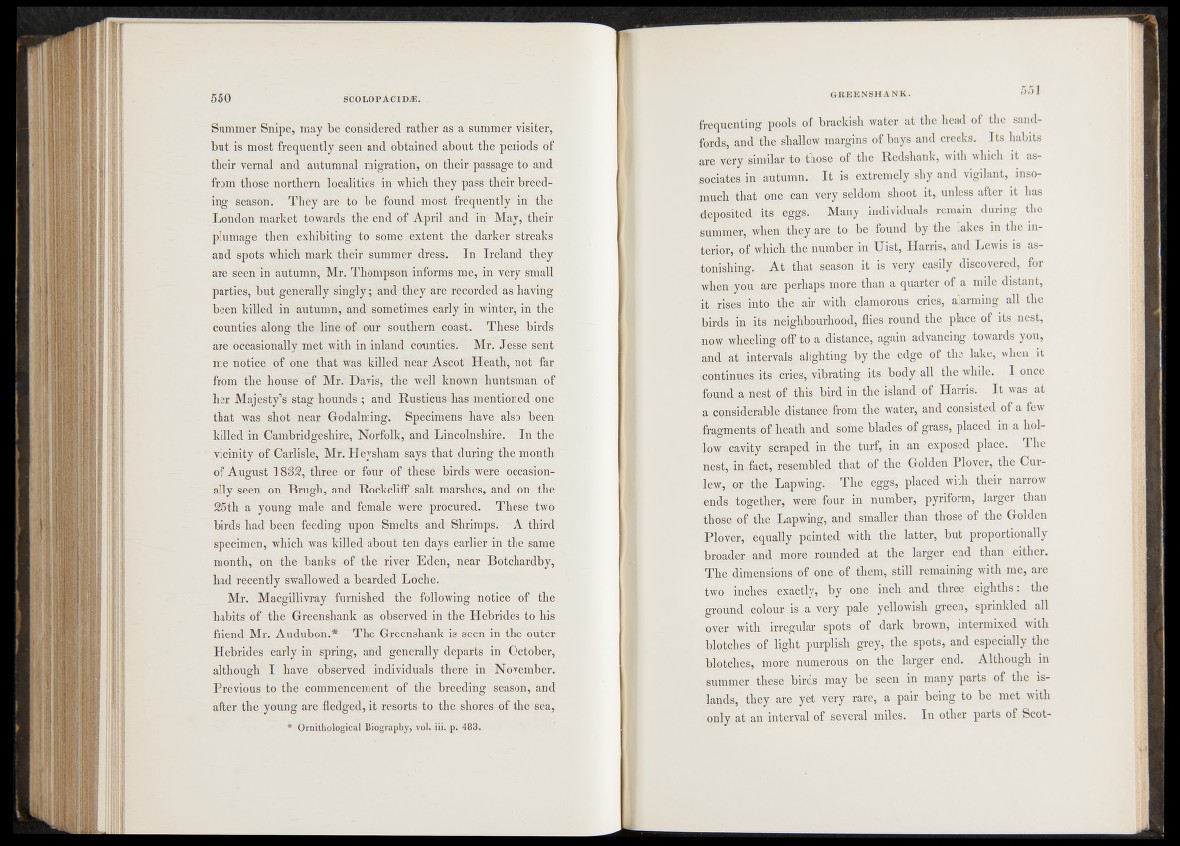
Summer Snipe, may be considered rather as a summer visiter?
but is most frequently seen and obtained about the periocfe~of
their vërnak and autumnal migratibhf'Ön ■theiT^palï%e-',t'o' and
from those’northern localities in which thëy pass thfeir breeding
season. They are to be^found móst frequently in the
London marke^towards the'endljof April and ^ ‘vMSy, their
plumage then“" exhibiting to some extent the darker streaks
and'spots which mark their stimïner dress. In Ireland the’y
are seen in autumn, Mr. Thompson informs ine, in u n ‘■mall
parties, but generally singly; and thëy'are recorded'as having
been killed in autumn, and sometimes early in winter, in" tile
counties along the line of - our southern coast. These birds
are occasionally met with in inland counties.“ Mr. J-èfese sént
me hoficeVjof one'that was-killed .near -Asco#feBeafK% not* "far
from the house' of Mr. Da\is, tlic‘ well known liuntsiiiaM'''(7f
her Majesty’s stag hounds ; and Rusticus has mentioned one
that was shof/near Godalming. Sjpecimens^have%Mh;“ bden
killed in Cambridgeshire^ Norfolk, and Lincolnshire. In tfic
vicinity o f Carlisle, Mr. Heysham 'says that during!||fe month
of August TSS2-, three m four of these birds were
ally seen on Brugh, and Rockcliffr M l marshes, and ’ on the1
' S5th a young male and'female were procured. These t\vt>
bird's had been feeding upon Smelts -and- Shrimps. ■ A third
specimen, which was killed about ten -day^MMieriip the same
month, on the banks óf the river "Eden, near Botehardby,
had rëcënt-ly swallowed“ a bearded Locheft^
Mr. Macgillivray furnished the following noticef o f the
habits of the Green shank as observed in the Hebrides, t o -his
friend Mr. Audubon.* The Gréenshank is seen in the outer
Hebrides early in spring, and generally departs in October,
although I have _ observed **nidividuals there in November.
Previous to the commencement of tne breeding season, and
after the .young are fledged, it resorts to the shores of the sea,
I OrniÜiDÏogical Biography, vól* iii. p. 483,
frequenting pools of brackish water at the head of the sand-
fords, and the shallow margins of bays and creeks. Its habits
are very similar torthqse .of the Redshank, with which it associates
in autumn. I t is. extremely shy and vigilant, insomuch;
that one can„ very seldom shoot it, unless after it has
,dg®©sited.- its ^egg^ Many individuals remain during the
summer, when they are t ^ b e 'found by the lakes in the interior,„;
of which the number in Uist,. Harris, and Lewis is as-
4-ojiis%g^- A t . ^ ^ e a s q n i ^ very?,easily discovered, for
when youf are perhaps, more, than .a quarter of a mile distant,
ib, .rises,-into, air with, clamorous cries, alarming all the
^{its-oeifU^Whodd, flks rou^the^place of its;0«ft,
S w w h e e lin g ^ # * a distance^ again advancing towards you,
and at intervals alighting by the edge3 of the lake, when it
■continues its cries, vibrating its body all the while. I once
found a^nest of this bird in the island of Harris.' I t was at
a qpj^idorabJfe dij^peiJrom th e a t e r , and consisted of a. few
fragments* pf ’heath u-nd^sOme .blades of grass, placed in a hol-
ilt<pyv fcayit,y scraped in the turf, in an- exposed place.. The
nq^t^ injfagt,. resembled^ that of the Golden Plover, the Cur-
or ■ $jhe Tjnpwiupv.^faiThe .eggs,. placed with. their narrow
endsijogethem were fourvin number,, pyriform, larger than
‘thp,se>ofKthc 5Lapwing, and ^smaller than thoge.of the Golden
Ploveri equally&gpinted with the latter, but proportionally
broader, and moire rounded ;at the larger end than either.
The dimensions of one .of them, still remaining with me, are
tm in ck e^ fiei^ y ;, by one inch and three eighths; the
ground -colour is a very pale. yellowish green, sprinkled a ll
^Qver" with irregular spoitp of dark brown, intermixed with
blotqhcs)of: light purplish grey, the spots, and especially the
blotches,,-mor^ numerous on the larger end. Although in
summer, these birds may be seen in many parts of the islands,
they, are yet very rare, a pair being to be met with
only at an interval of several miles. In other parts of Scot